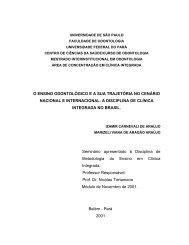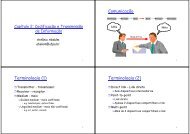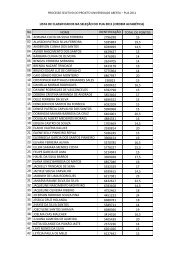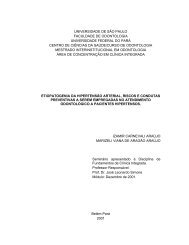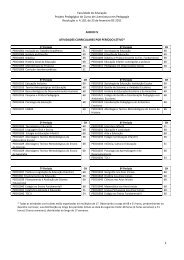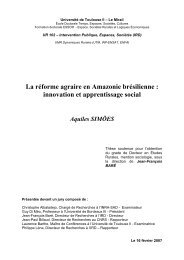Chapter 3 Switching and switch control 3.1. Introduction
Chapter 3 Switching and switch control 3.1. Introduction
Chapter 3 Switching and switch control 3.1. Introduction
You also want an ePaper? Increase the reach of your titles
YUMPU automatically turns print PDFs into web optimized ePapers that Google loves.
Figure A.3.4 B<strong>and</strong>width requirements for different telecommunications servicesThe requirement for good network economy applies especially to the capacity of the<strong>switch</strong>ing equipment to h<strong>and</strong>le multiplexed traffic that consists of packets. The packetmodetechnique is a consequence of the requirement for more efficient use of lines.This technique can also be used to integrate services. For example, ATM technologyenables both integrated transmission <strong>and</strong> integrated <strong>switch</strong>ing.Different <strong>switch</strong>ing techniques are dealt with in Sections 3.3 - 3.6.3.2. historyA.3.2.1 Manual systemsIn the infancy of telephony, telephone exchanges were built up with manually operated<strong>switch</strong>ing equipment. The first manual exchange was installed in New Haven, USA, in1878. The operators received calls <strong>and</strong> <strong>switch</strong>ed them manually to the calledsubscriber (the operator set up a "circuit" between two subscribers, hence the termcircuit <strong>switch</strong>ing). When the call was complete, the operator released the connection.We might say that the operator was the "<strong>control</strong> system" of that era. (See note inSubsection <strong>3.1.</strong>1.)A.3.2.2 Electromechanical systems
In the years that followed, the manual exchanges were replaced by automaticelectromechanical <strong>switch</strong>ing systems. Although these systems required moremaintenance, their overall impact was positive since the number of operators could bereduced significantly (resulting in cut labour costs). The systems provided increasedtraffic capacity at a lower cost, preparing the way for a continued rapid expansion ofthe telecommunications network. The new systems also made it possible to routetraffic more efficiently through the transmission network, reducing the need for cablecapacity.Almon B. Strowger, Kansas City, USA, is regarded as the father of automatic <strong>switch</strong>ing.In 1889, he applied for a patent for an automatic telephone exchange. Since then,Strowger's name has been associated with the step-by-step selector (<strong>control</strong>leddirectly from the dial of the telephone set) which was part of his idea.Afterwards, developments followed in the direction of register-<strong>control</strong>led systems, inwhich the number information does not directly <strong>control</strong> selector set-up (as in the stepby-stepselector), but is first received <strong>and</strong> analysed in a register. One of the functionsof the register is to select alternative <strong>switch</strong>ing paths, meaning that the transmissionnetwork can be used more efficiently.Examples of register-<strong>control</strong>led systems are:• the 500-line selector (1923); <strong>and</strong>• crossbar systems (1937).3.2.3 Digital, computer-<strong>control</strong>led systemsTelephone exchangesAs time went by, transmission as well as <strong>switch</strong>ing systems continued to develop,contributing to the total economy. A technique for saving expensive connections wasintroduced into the long-distance networks: frequency division multiplexing (FDM).This technique was developed around 1910, but was not implemented until 1950 whenabout 1,000 channels were transferred on the same cable (the coaxial cable).Digital multiplexing (based on PCM), which was introduced around 1970, also madetransmission networks less expensive while at the same time improving transmissionquality. Costs were further reduced when digital group <strong>switch</strong>es (the actual <strong>switch</strong>ingequipment in the telephone exchange) were combined with digital transmissionsystems, eliminating the need for many relatively expensive analog-digital (A/D)converters. It now became necessary to computerise the <strong>control</strong> of the exchanges, <strong>and</strong>before long, not only the group <strong>switch</strong>es but the entire exchanges were digital. Thefirst computer-<strong>control</strong>led exchange was put into service in 1960 in the US; the firstdigital exchange in Europe was opened for traffic in 1968 (Tumba, Sweden). See alsoSubsection 3.<strong>3.1.</strong>Today's telephone exchanges use circuit <strong>switch</strong>ing technology, just like theirpredecessors at the end of the 19th century.Special nodes for data communication
The strong growth in data traffic <strong>and</strong> in the number of users of data communicationhas resulted in the development of separate data networks <strong>and</strong> data <strong>switch</strong>es. In manycases, these can meet users' increasingly stringent quality requirements <strong>and</strong> the needfor higher transmission rates in a better <strong>and</strong> less expensive way. Packet mode <strong>and</strong>frame relay, for example, provide efficient network utilisation, enable packets to beretransmitted when errors occur on a link (applies to packet mode only), <strong>and</strong> allow forsorting, routing, <strong>and</strong> buffering.Nodes for N-ISDNDevelopments for providing service-integrated networks (for voice, video, <strong>and</strong> dataservices) require both public <strong>and</strong> private N-ISDN nodes (N st<strong>and</strong>s for narrowb<strong>and</strong>). Inprinciple, a complete ISDN node can be seen as a combination of today's telephoneexchanges <strong>and</strong> packet data <strong>switch</strong>es (circuit <strong>switch</strong>ing <strong>and</strong> packet mode), with animportant sorting function for subscriber traffic.Nodes for B-ISDNThe technology called ATM, which applies the cell-<strong>switch</strong>ing technique <strong>and</strong> which formsthe basis of B-ISDN (B st<strong>and</strong>s for broadb<strong>and</strong>), is not yet completely st<strong>and</strong>ardised. Seealso Part G of Volume 2, where ATM <strong>and</strong> B-ISDN are described.Optical <strong>switch</strong>esIt is primarily the <strong>switch</strong>ing equipment that limits the b<strong>and</strong>width of a connection.Today, we can make use of very high bit rates, up to tens of billions of bits per second(tens of Gbit/s) in optical transmission systems. However, in <strong>switch</strong>ing equipment, wemust change over to electrical signals <strong>and</strong> considerably lower bit rates.The next step is to use optical <strong>switch</strong>ing with electronic <strong>switch</strong> <strong>control</strong>. And in time, wewill most assuredly have fully optical <strong>switch</strong>ing systems. Indeed, in view of theintensive research <strong>and</strong> development that is being carried out in this area, it should notbe long before the first optical space <strong>switch</strong>es are commercially available.Figure A.3.5 describes technical developments in the field of <strong>switch</strong>ing (public<strong>switch</strong>ing only).
Figure A.3.5 Developments in <strong>switch</strong>ing




